2019 Wharton Leadership Conference: Leading in a Context of Conflict
by Elizabeth Johnson

Gathering top leaders from a breadth of backgrounds and experience, the 23rd annual Wharton Leadership Conference on June 12, 2019 tackled the vital issues surrounding “How to Lead in a Context of Conflict.” Conflict and crisis come in many forms in today’s business landscape: natural and national disasters, organizational and industry crisis, diversity and inclusion challenges, and political turmoil, as addressed by Former Governor Jeb Bush. What’s more, the rapid pace of development of new technology and innovation has created the state of heightened conflict in which we operate each day. As the conference speakers continually reinforced, we cannot avoid conflict in any sphere of business. How a leader prepares for and deals with conflict and disruption can determine the success of an entire organization.
Former Aetna CEO Ron Williams On Learning to Lead Yourself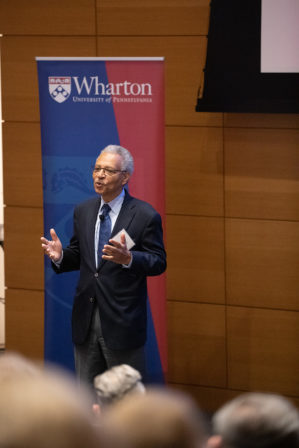
Ron Williams wanted to title his recent book “Do the Impossible” because he considers his rise to CEO of Aetna as nearly impossible. The son of a bus driver and manicurist, he is keenly aware of each step he took on the road to success, and he has paid close attention to the leadership skills that helped him along the way.
Williams’s skills were put to the ultimate test in 2001 when he took over Aetna and found himself plunged into a company in deep crisis. After experiencing a $290 million loss his first year, Williams turned the company completely around. In his final year, he left Aetna with $2 billion in profit and an industry-leading reputation.
Reflecting on his career, Williams identified four crucial phases: learning to lead yourself, learning to lead others, learning to lead organizations, and learning to lead yourself again after you have led organizations. “Leaders aren’t just born,” Williams declared. “Some have more capabilities out of the gate, but most people can learn to be an exceptional leader with the right training, development, self-awareness, and feedback.”
This development includes focusing on learning, growing, and being honest with yourself and your team. Williams believes concentrating on talent, building effective teams, paying close attention to culture, unlocking discretionary energy, and encouraging debate are also key to successful leadership.
Above all, Williams maintains that self-awareness is absolutely necessary for effective leadership. And yet, as CEO, you do not have the level of feedback you had previously. Taking on the role brings both great privilege and serious obligation, he said.
“As a leader, the single biggest challenge you have is managing yourself effectively. Your voice is amplified 20x.”
From Cable Splicer to CEO: Ivan Seidenberg’s Transformational Leadership of Verizon in a Time of Technological Disruption
 Like Ron Williams, Ivan Seidenberg began working his way up the corporate ladder from the bottom rung. He started at Verizon as a cable splicer’s helper. 40 years later was the company’s CEO – a role he would excel in for 20 years. Over the course of Seidenberg’s career at Verizon, the company repeatedly found itself in the midst of significant technological disruption. What began as a phone utility would transform to a wireless company and ultimately into a technology and network company.
Like Ron Williams, Ivan Seidenberg began working his way up the corporate ladder from the bottom rung. He started at Verizon as a cable splicer’s helper. 40 years later was the company’s CEO – a role he would excel in for 20 years. Over the course of Seidenberg’s career at Verizon, the company repeatedly found itself in the midst of significant technological disruption. What began as a phone utility would transform to a wireless company and ultimately into a technology and network company.
“I define my role, always did, as owning the future,” Seidenberg told participants at the Conference. While he was not in charge of a company in financial trouble, Verizon had no growth and he saw that as a huge problem. So Seidenberg committed to rebuilding the broader industry and making sure his company was a vital part.
“We bought 100 companies, built a wireless business, built Fios – did things no one ever thought a utility would do.”
As Verizon began to evolve and grow, one innovation Seidenberg implemented was using external benchmarks for success. He focused on being top in the marketplace and was not content to improve simply based on past internal performance. He also believed strongly in the town hall concept of bringing together a company with offices all over the country – giving employees the chance to hear directly about product announcements, labor relations, and government issues.
“What binds people together is a mission or purpose bigger than themselves,” Seidenberg said. To further drive this home at Verizon, he replaced all rectangular tables in the company with round ones, fostering a culture of input and conversation.
“When you have a round table everyone is the same.”
Seidenberg’s leadership continued to grow and evolve throughout his tenure as CEO. In the end, he came to see the need for four paramount values: respect, integrity, operational excellence, and accountability. And these values, he noted, remain ingrained in Verizon’s culture today.
Mark Turner of WSFS Bank on Creating Constructive Conflict
“Have you ever wanted to, or do you wish that you could, take three to four months away from your job, out of the office completely – no responsibilities, paid by your company, go out 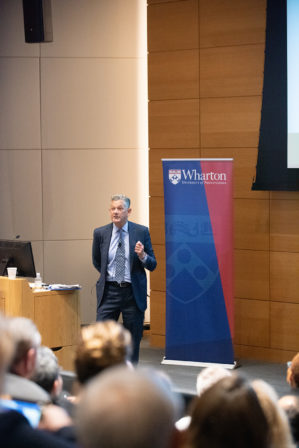 and visit with dozens of interesting other companies, meet with their executives, talk with them about their leading practices, what makes them different, what they learned along the way?” asked Mark Turner.
and visit with dozens of interesting other companies, meet with their executives, talk with them about their leading practices, what makes them different, what they learned along the way?” asked Mark Turner.
Turner, as CEO of WSFS Bank, had the chance to do just that three years ago. He embarked on 49 cross-country visits to leaders and companies doing interesting and innovative things – from Apple to Walmart to brand new startups. Then, most important, he came back to his company and began to lead real change.
In so doing, Turner was as a “serial disruptor” – one of the traits he finds critical to success as a leader. A serial disruptor does not simply manage change, but proactively and routinely seeks it out. The serial disruptor unsettles the organization’s ego and success, while being mindful of the pace of change in the industry.
Along the way, Turner noted a “dynamic dozen” of common aims shared by highly effective CEOs: setting the course, communicating effectively, embodying purpose driven ambition, setting high standards, showing self-awareness, serving as a “connector,” creating cohesive teams, building external constituents, enhancing culture, spotting and pursuing value opportunities, and focusing on execution.
Of these, he considers self-awareness to be the most important, including self-reflection, self-correction, self-confidence, and efficacy.
When Turner returned to WSFS he distilled all that he had learned on his travels into a variety of ways he wanted to change the organization over time. His greatest act of serial disruption in his role of CEO was to remove himself from the position, after deciding in advance the ideal amount of time he would be most effective in the role.
In his words, “The best way to avoid being disrupted is to disrupt yourself.”
Former Governor Jeb Bush: Say What You Are Going to Do and Then Do It
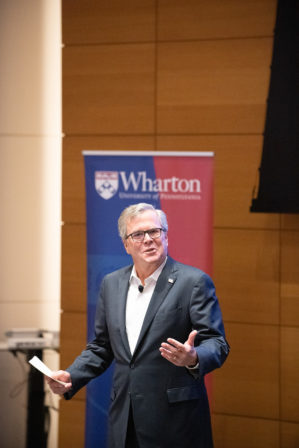 As a businessman turned politician, Jeb Bush took business principles and applied them to the political sphere, and now he has found that the reverse is also true. Decisions have to nurture the workforce and stakeholders, not just shareholders – and this mirrors his experience as governor.
As a businessman turned politician, Jeb Bush took business principles and applied them to the political sphere, and now he has found that the reverse is also true. Decisions have to nurture the workforce and stakeholders, not just shareholders – and this mirrors his experience as governor.
With this in mind, Bush shared six lessons on how to excel in leadership, especially in times of crisis:
- Say what you are going to do and then do it
- Create aspirational goals
- Ask why not?
- Be the HR talent officer and develop the skills of your workers
- Communicate consistently and constantly
- Stick with it and show dogged determination
“The bigger the idea, the bigger the cause, the more you have to stick with it over the long haul,” Bush told the conference. And he believes the big ideas are worth fighting for.
Referring to “big hairy audacious goals” or “BHAGs,” Bush encouraged the conference participants to tackle their most vital goals without letting the little stuff get in the way. He believes it is easy to get caught up in the day-to-day “tyranny of the present,” but it is necessary to set your sights past that to achieve real change.
“Once you get into the momentum of a big idea more ideas come, so be big and bold – you can change the paradigm you are operating in if you have enough focus and energy.”
As for the current paradigm, Governor Bush reflected, “We’re living in a time of massive disunity and people in public life have a responsibility to be more unifying….Our country works really well when we have a set of shared values, and our diversity becomes a positive catalyst. But when we divide and vilify other groups, it is destabilizing for people’s optimism for the future. We are seeing this disruption that is really dangerous.”
Moving forward, effective leaders – whether local, national, or global – need, Bush explained, to create an environment in which everyone is comfortable asking “why not?” and, moreover, young people are empowered and supported to achieve more than they can even imagine.
Accenture’s Rahul Varma Urges Compassion in Era of Disruption
Rahul Varma of Accenture emphasizes that we are living in “an era of epic disruption” and, as a result, leaders must be “responsible and compassionate.”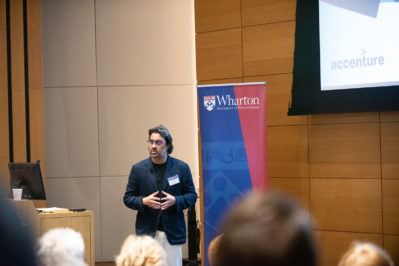
The current disruption stems from the unprecedented convergence of several game-changing new technologies emerging at the same time. Pervasive innovations like AI, cloud computing, mobility, and blockchain are altering the landscape of business and fundamentally changing the nature of the workforce. Whereas previous technological developments have primarily undercut factory-level jobs, AI will impact the middle.
What’s more, this disruption has no end in sight, and the disruption is compounded by geopolitical instability. We are in “an era unlike anything before,” Varma stated.
So what is to be done? Varma and Accenture proposed upskilling and gave the example of Dorian – a former mortgage professional turned technologist. When her former role became obsolete, Accenture trained Dorian and her colleagues in a new skill that was in drastically higher demand.
“We have an obligation to constantly reskill ourselves and our people,” Varma implored the group. “Continuous learning will be a requirement and a way of life in the future.” Accenture has begun investing 60 cents from every one dollar saved by automation, and as a leader in its industry, the company feels an obligation to share this message.
“This is not just the important thing to do, it is the right thing to do.” Because, as Varma concluded, “in addition to learning to lead, we also need to learn to love.”
Judith Rodin Urges Organizations to Bounce Back Better by Practicing Resilience
 Former University of Pennsylvania President Judith Rodin had an important message to share: the need to practice resilience and plan ahead for crisis.
Former University of Pennsylvania President Judith Rodin had an important message to share: the need to practice resilience and plan ahead for crisis.
Presenting several case studies to the group, Rodin illustrated time and time again that good leaders prepare for things to go wrong and they charge head-on into problems when they arise. Handled wisely, an organization can bounce back from a crisis stronger than ever before. But mismanaged, crisis quickly reveals underlying problems and spells disaster.
“Resilience is a skill that can be taught and learned, developed, and practiced,” Rodin explained. As such, she identified five core competencies to help develop resilience: awareness, diversity, integration, self-regulation, and adaptiveness. These competencies are not optional for leaders, Rodin urged, they are absolutely essential.
When the crisis sets in, be flexible – bend, but do not break. What’s more, Rodin says, be mindful of the qualities you bring to your leadership position day after day and week after week: Fully understand your organization and its mission, never stop listening, don’t fear risk, innovate, leverage, communicate, create a culture of trust, prioritize talent, set specific goals, and “steward your chips – and spend them wisely.”
A resilient leader needs a strong foundation and the tools available to grow and turn crisis into opportunity. “As leaders you can rely on these tools to help you make profound changes – from reacting to changing to shaping it.”
Because, as Rodin quoted Penn founder Benjamin Franklin, “When you’re finished changing, you’re finished.”
Admiral Michael Rogers, U.S. Navy (ret.) on Leading Cyber Command and the NSA in Times of Extreme Conflict and the Highest of Stakes
When President Obama praised Admiral Michael Roger’s team for providing 90% of the intel in the counterterrorism fight, Roger’s reaction was not to rest on his laurels. His very first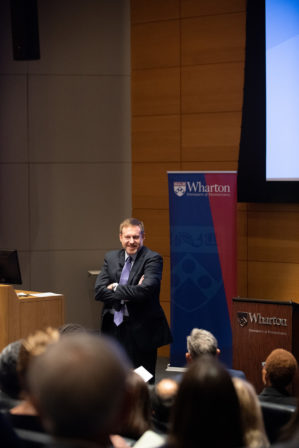 thought was “how to make sure a president in ten to fifteen years says the same thing.”
thought was “how to make sure a president in ten to fifteen years says the same thing.”
The military, Rogers explained, “prizes leadership over all other traits. You are first and foremost there to be a leader.” And Admiral Rogers has not shied away from this ethos – having led U.S. Cyber Command as well as the NSA at different points in his career with the U.S. Navy.
For Rogers, the key to successful leadership is accountability, especially in times of crisis. “If you are a leader and something goes wrong, you have to be accountable,” he asserted. It is also vital to develop and articulate a strategic vision for the future, as well as set and communicate broad boundaries for your team. “You have got to set up your people so they are in a position to make decisions that align with your vision.”
“Every crisis is an opportunity,” Rogers added. “Never let a crisis go to waste.” Particularly in a large bureaucracy, a crisis can offer the chance to move outside of comfort zones and force positive changes that might not otherwise have been possible. Your responsibility as a leader, Rogers insists, includes asking questions about how to be successful in the future. You have to be willing to take a step back and anticipate what might need to change in order to meet high performance and industry leading goals.
What’s more, “if you want to do something foundational, then you have got to get the team to own it.” And, Rogers urged, a leader must build the best team possible. On a team, “broader experiences mean broader perspectives, which lead to better mission outcomes.” This means ensuring that diversity is not merely a check box, but an absolute, resource-driven priority.
Looking back on his career and experiences, Rogers reflected on the specific lessons he has learned from the crises he has weathered. His response was twofold: do not make a decision before it is time, and never underestimate the importance of communicating with your team and ensuring everyone is on board.
“You can never communicate enough,” Rogers said. “You have got to communicate with your team. Help them understand not just the what but the why.”
Bill McNabb of Vanguard Shares Hard-Earned Lessons in Leadership
 “Strategy is the fun part” according to Bill McNabb, former Chairman and CEO of Vanguard. “But if you don’t have the right people and right talent it doesn’t matter. Having the right talent ends up being the most critical … to have great talent you need great leadership.”
“Strategy is the fun part” according to Bill McNabb, former Chairman and CEO of Vanguard. “But if you don’t have the right people and right talent it doesn’t matter. Having the right talent ends up being the most critical … to have great talent you need great leadership.”
Without great leadership, even once-prosperous companies eventually fade – something McNabb has seen time and time again, particularly in times of volatility. And that volatility, McNabb noted, is on the rise. Over the next decade, he predicts increased volatility with little return.
So what can a leader do to ensure success in this tumultuous environment? McNabb’s answer is threefold: growth mindset and grit, high performing teams, and level five leadership.
Growth mindset entails the ability to adapt and evolve, while level 5 leadership means putting the organization’s success first. “Turn your org charts upside down,” urged McNabb. The people who interact with the customer are the heroes, and the role of the executives is to clear things away so that front line can do their jobs better.
The concept of high performing teams, meanwhile, is one that is easy to understand but challenging to execute. “For a team to work well it all starts with trust,” McNabb told the audience, and that trust fosters vital collaboration. Results, accountability, commitment and constructive conflict are also integral to a high performing team.
But what happens to an organization once it has mastered these skills and achieved industry-leading success? McNabb’s answer is to employ the flywheel model and take an honest look at what your company is passionate about, what it can be the best in the world at, and what drives its economic engine. Then, he said, examine and implement what it will take to keep the interconnected flywheel spinning.
McNabb maintains that more successful you are as an organization and a leader, the more necessary it is to evolve and adapt. Otherwise, he said, “you are most vulnerable then to fall into complacency, and that is the beginning of downfall.”
Leading Diversity in a Context of Conflict with Wharton’s Stephanie Creary
Wharton Professor Stephanie Creary understands that when we get diversity right, “we drive growth personally and for our organization.” She also understands that this is by no means 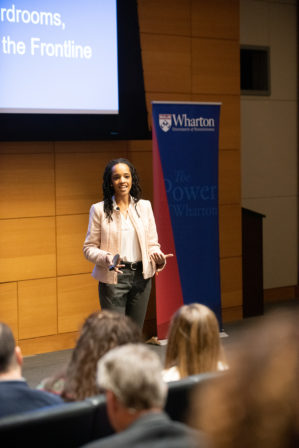 easy – but it is absolutely doable.
easy – but it is absolutely doable.
Creary explained that historical conversations around workplace diversity have been rooted in a focus on equity. But what began during the civil rights movement as a concentration on legal exclusion has expanded over time to address diversity, inclusion, belonging, and respect as well.
Today, we have come a long way in understanding the value of these terms, but we struggle to “hold all of these ideas constant without prioritizing one over the other.” To continue to move forward constructively, we need to take a LEAP; in other words, we need to put a priority on Looking, Engaging, Asking, and Providing.
Taking a LEAP can include helping others to see different experiences and backgrounds, helping to do what is in our power to change, and helping to advocate for our peers.
At all levels of the workforce – from entry level to board members – diversity improves employee experiences and organizational outcomes. And it is the responsibility of an effective leader to continue to direct the conversation forward for the betterment of all.
Conclusion
As the conference concluded, it was clear to all in attendance that conflict and crisis were inevitable in the business world today as in our society as a whole. But each participant also emerged with a way to prepare for and deal with these disruptions as an effective leader. Self-awareness, communication, accountability, and resilience were common keys integral to the leader’s success. By keeping these keys in hand, leaders and organizations will weather times of crisis and, moreover, come out on the other side even stronger than before.

Return to the main Leadership Digest page


